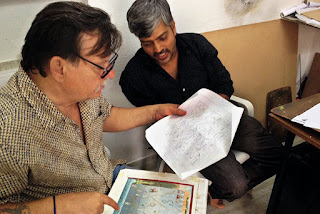(Waswo with his Karkhana People)
In ‘Karkhana: A Studio in Rajasthan’, the latest book by
artist Waswo x Waswo one could see/feel the spirit of a Ruskin Bond narrative.
Bond loves his Mussoorie and Waswo loves his Udaipur. Bond had made India his
home in 1960s itself; a sojourn in London was suffocating for him. Waswo spent
his youthful days in Milwaukee and hit the road when the rural borders were
closing in on his mind. Interestingly, in India he had his first professional
exhibition at the Kashi Art Gallery, Fort Kochi in 2002. He fondly remembers
late Anoop Skaria and Dorrie Younger who had recognized his ‘genre-less’ works,
when the Indian art market was undergoing the labor pain. Since then Waswo
never had to look back. Though the artistic journey was partly on bumpy roads
he has finally settled down in Udaipur, Rajasthan, which he could easily claim
as his home now.
Waswo works with a team of local artists and the book tells their story. Seen through the eyes of the narrator these local artists come across as legendry characters from the yellowing annals of a local gazette. The word Karkhana literally translates as a factory and the word factory brings in the mind a picture of assembly line works. This is where Marx had found alienation as the splitting factor that separated the worker from the product. In that sense, Karkhana has a different meaning altogether, perhaps a contrary one. Karkhana is an atelier led by a master artist where skillful assistants work on parts but still have an idea about the final outcome. Assistants could earn their own status either by choosing an independent course or by finding a patron and initiating a different karhana. Traditionally, artists/assistants in a Karkhana do not part ways with the master/s not only because the patronage was far and wide but also because their existence was based more on trust and style.
(Work by Waswo and his Karkhana)
Trust is something that cannot be fixed always in a signed
bond. A written document may be legally binding for the parties but the
unwritten trust between people who operate within a society is more reliable.
Waswo was and is lucky to find a few artists in due course of time as he
settled in Udaipur. He was in the right place at the right time and had the
right attitude to make friends with the local artists and artisans. The growth
was mutual as the local artists could extricate themselves from the demands of
the tourist bazaar for making cheap and mechanical and lifeless reproductions
of the stock images that defined ‘Rajasthan’ as a place and culture frozen in
time, and in the meanwhile Waswo could negotiate with the problematic
position/ing of his own artistic self as a ‘white westerner’ both in his
mundane and creative existence. He started off as an ‘Evil Orientalist’ only to
shed the honorific soon to become a benevolent collaborator and director of
many selves in the creative process.
(Waswo and team)
The book tells the story of the collaborators; Rakesh aka R.Vijay,
the miniature artist, Rajesh Soni, the hand colorist on black and white
photographs, Shankar and Chirag Kumawat, the father-son duo who paint intricate
borders on wasli papers, Dalpat and Banti Jingar brothers, who could paint
backdrops and could faithfully reproduce exquisitely painted palace interiors
in many frames without fault, Ganpat Mali and Jay Prakash who are multi-purpose
studio hands who add a lot of value to the Karkhana process created by Waswo.
There are many other side characters who come and go , and even at times pose
for the photographs that eventually become full-fledged works of art as they
pass through the hands of the above mentioned artists under the watchful
direction of the mastermind, Waswo himself.
Though the book is titled as Karkhana, the structure is that
of a journey, sometimes on an Enfield Bullet and other times in a multi-utility
van, driven by Ganpat Mali and Waswo on the pillion. The time is spread over a
few years but the narrative is arranged in such a way that the reader feels
that the whole thing happened on a hectic day; from early morning to night. The
narrative unfolds in a reverse order. We see the border makers first and then
the backdrop painters who make the broader decorative strokes in the works of
Waswo. Then we go to the master artist, R.Vijay who, faithful to the miniature
tradition of Rajasthan, recreates it for a modern aesthetic purpose with a
sense of irony and a lot of personal touch. Today, R.Vijay is Waswo or vice
versa. Each time, with the riders we too get down from the motorbike and walk
into the artists’ homes or work places and what come alive are the little
precious gems of their biographies.
(Waswo and R.Vijay)
Waswo has written this book during the lockdown days.
Udaipur streets are no longer abuzz with touristic activities. But the local
life goes on. And in Waswo’s narrative one could feel the heat, dust and
loneliness of the pandemic hit streets. However, the jovial nature of the collaborators
is never gone as Waswo keeps their pay roll on with bonuses. R.Vijay underplays
the hardships of the times by painting an abandoned surgical mask and a bisleri
bottle, the iconographic details of the fedora man, the former evil
orientalist. The book ends up in a party at the Varda studio and the night
followed by that. In a way that chapter is a stock taking shot in a movie where
the cast and crew gather for a party, a movie within a movie, a narrative
within the narrative with the characters becoming living men and a few women in
long shot or in fade out.
(Waswo x Waswo)
Karkhana is a collective biography or rather a collective autobiography
written by one person. Their lives are now intricately mixed up and positively
the symbiotic relationship is not collapsed by surreptitious offers or breach
of trusts. May be because Waswo remains the master mind and the glue that holds
all together; without them, may be they are just border painters, backdrop
makers, miniature artists and photo colorists. I do think that even mentioning
such a dissection of roles is rude. The book, beyond its literature part also
functions as a documentation of the works that they have so far collaborated,
especially during the last few years including the pandemic ones. But without
the literature, it is just another book of Waswo’s works. In creating that
literature, Waswo has generated a post-colonial and truly global documentation
on decentralized collaboration (not of the sweatshop version of the corporate
like works of art) of artists where each one is acknowledged without fudge. One
cannot complain about alienation here anymore. A must read for the art lovers.
-JohnyML
















